The term stormuring is becoming increasingly common across weather analysis, environmental safety, and urban planning discussions. Although not yet part of mainstream vocabulary, stormuring is used to describe the rapid intensification, clustering, and unpredictable movement of storm systems within a short time frame. It refers to a pattern where atmospheric conditions align in such a way that storms grow stronger, merge, or shift suddenly, creating challenges for forecasting and disaster preparedness.
As climate volatility rises, understanding stor-muring has become crucial for communities, emergency responders, and infrastructure planners who must anticipate severe weather behavior and minimize potential damage.
Understanding the Concept of Stormuring
Stor-muring represents a combination of meteorological factors that cause storms to evolve faster or in more complex ways than traditional patterns. It does not describe a specific type of storm but rather the behavior of storm systems as they interact.
Key characteristics of stormuring include:
-
Rapid storm intensification
-
Abrupt changes in storm direction
-
Merging of two or more storm cells
-
Sudden temperature or pressure drops
-
Increased wind shear and turbulence
Stormuring can occur in hurricanes, thunderstorms, cyclones, or even large-scale rain systems, making it a versatile concept within climate studies.
What Causes Stormuring?
Stormuring occurs when multiple atmospheric conditions interact simultaneously. These conditions amplify storm behavior, creating unpredictable weather patterns.
1. Temperature Imbalance
Sharp contrasts between warm and cold air masses enrich a storm’s energy supply. When these temperature differentials intensify, stormuring becomes more likely.
2. High Moisture Levels
Warm oceans, lakes, and humid air contribute to rapid cloud buildup—fueling sudden storm intensification.
3. Atmospheric Pressure Shifts
Unstable pressure zones create pathways for storms to merge or move erratically.
4. Wind Shear Variations
When wind direction or speed changes sharply with altitude, storm systems deform, split, or combine—key triggers of stor-muring.
5. Climate-Driven Volatility
Changes in global weather patterns contribute to unstable atmospheric layers, increasing the frequency of stormuring events.
How Stormuring Affects Weather Predictions
Stormuring challenges meteorologists because it interferes with traditional forecasting methods. Historically, storms follow somewhat predictable paths, but stormuring introduces rapid changes that models sometimes struggle to capture.
Forecasting challenges include:
-
Sudden strengthening of storms
-
Difficulty determining storm movement
-
Formation of unexpected storm clusters
-
Rapid rainfall accumulation
-
Short lead times for weather warnings
Because of stormuring, communities may receive shorter preparation time when severe weather forms, making modern forecasting tools essential.
The Impact of Stormuring on Communities
Stor-muring has practical consequences that affect safety, infrastructure, economy, and daily life.
Common impacts include:
-
Flash floods from sudden rainfall
-
Strong winds damaging homes, trees, and power lines
-
Rapid storm surges in coastal regions
-
Transportation disruption (air, road, sea)
-
Increased risk for outdoor workers and travelers
Regions with limited drainage or older infrastructure are especially vulnerable to stormuring-related damage.
Stormuring and Urban Planning
Urban planners increasingly consider stormuring when designing resilient cities. As storms behave more erratically, modern infrastructure must withstand unexpected stress.
Planning strategies include:
-
Upgrading drainage systems
-
Creating green spaces to absorb sudden rainfall
-
Building wind-resistant structures
-
Installing real-time weather monitoring systems
-
Developing emergency response zones
Cities that integrate stormuring awareness into their planning reduce long-term damage and recovery costs.
How Technology Helps Detect and Track Stormuring
Advancements in meteorological technology have improved the ability to detect early signals of stor-muring.
Tools and methods include:
-
Doppler radar to monitor wind rotation and storm strength
-
Satellite imagery that captures cloud formation and temperature changes
-
Artificial intelligence used to predict storm intensification patterns
-
Ground-based weather sensors for real-time tracking
-
High-altitude balloons to measure pressure and humidity shifts
These technologies create faster alerts, helping communities prepare quickly.
Stormuring in Coastal vs. Inland Regions
Different regions experience stor-muring differently based on geography.
Coastal Areas:
-
More vulnerable due to warm ocean waters
-
Higher risk of storm merging and intensification
-
Increased chance of storm surges
Inland Areas:
-
Experience sudden heavy rainfall
-
Greater risk of flash floods
-
Storm clusters forming along temperature boundaries
Understanding regional differences helps improve safety planning.
How to Stay Safe During Stormuring Events
Since stor-muring can occur quickly, preparation is essential.
Safety tips:
-
Monitor real-time weather updates
-
Keep emergency supplies stocked
-
Secure outdoor items that may become windborne
-
Have a family safety plan and evacuation route
-
Avoid driving during sudden storms
-
Stay indoors during lightning-heavy systems
Preparedness reduces risk significantly during unpredictable storm behavior.
Preventing Stormuring Effects Through Environmental Policy
While stor-muring itself cannot be stopped, its effects can be managed through environmental strategies.
Effective preventive measures include:
-
Strengthening natural barriers like wetlands
-
Reducing land development in flood zones
-
Improving water management systems
-
Promoting sustainable land use
-
Expanding early-warning networks
Environmental policy plays a major role in reducing the severity of stor-muring impacts.
The Future of Stormuring Research
Scientists continue studying stor-muring to understand how atmospheric changes influence storm behavior. As weather patterns evolve, research focuses on:
-
Improved prediction models
-
Climate-resistant infrastructure design
-
Enhanced global monitoring systems
-
Advanced emergency communication networks
Continued research helps societies adapt to increasingly unpredictable storm behavior.
Conclusion
Stormuring is a powerful reminder of how quickly weather patterns can shift. By understanding its causes, effects, and warning signs, communities and planners can take proactive steps to increase safety and resilience. With better technology, environmental strategies, and public awareness, the risks associated with stormuring can be managed effectively.
Whether you live near a coast, in a city, or in rural areas, being informed about stormuring ensures better preparation for sudden weather changes.






